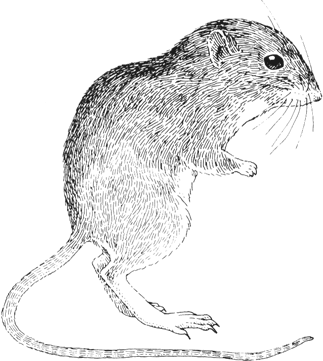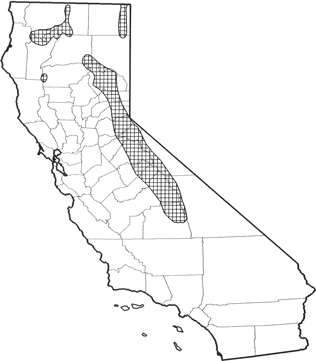
Western Jumping Mouse
Distribution, Abundance, and Seasonality
In California, the western jumping mouse is distributed in the Sierra Nevada from southeastern Shasta Co. south through Plumas Co. to northeastern Tulare Co. It also is found in north-central California in Siskiyou and Trinity cos., in eastern Modoc Co. and in western Tehama Co. Probably distributed throughout north-central and northeastern California, though confirmed locality data are sparse (see Hall and Kelson 1959, Hall 1981). Jumping mice are confined to wet areas in a variety of coniferous forest, riparian, and grassland habitats. Locally common to abundant in thick, herbaceous vegetation near water.

Range Map
Specific Habitat Requirements
Feeding: Feeds on grass and forb seeds, although insects and the stems and leaves of herbaceous plants are eaten seasonally. In Colorado, arthropods became an important diet element as forb seed availability decreased (Vaughan and Pearse-Weil 1980), with arthropods comprising 63% of the diet in June samples. Seeds are thought to be an important food for fat deposition prior to hibernation.
Cover: Requires dense herbaceous cover near water. Moist soil is required for burrow construction. Hibernates in winter in nests of grass, leaves, and other vegetation, constructed underground, or beneath logs or brush piles.
Reproduction: Grassy nests are placed in depressions in the ground, beneath dense vegetation, slash, or in burrows.
Water: Probably requires free water for drinking, but close associations with water may reflect a requirement instead for dense herbaceous cover.
Pattern: Wet grassy areas near water.
Species Life History
Activity Patterns: Nocturnal. Hibernates from about September to May, the exact dates depending upon snowfall and melt.
Seasonal Movements / Migration: None.
Home Range: In Colorado, home ranges averaged 0.17 to 0.31 ha (0.42 to 0.77 ac) for males, and 0.10 to 0.24 ha (0.25 to 0.6 ac) for females (Meyers 1969, Stinson 1981). In Wyoming, home ranges extended 100-400 m (328-1300 ft) along streams (Brown 1967b). In Colorado, the distance between captures was 96.5 m (318 ft) for males, and 78.5 m (259 ft) for females (Stinson 1981).
Territory: Stinson (1981) reported that males tend to be more tolerant of each other, whereas females are more territorial.
Reproduction: Breeds from June to August. Nesting is solitary. Gestation period 18-21 days in Z. hudsonicus (Godin 1977). Litter size average 5.4 young (range 2-8). Probably 2 litters per yr. Weaning occurs at 4 wk of age, and sexual maturity is attained in the spring following birth. Longevity is about 2 yr (Godin 1977).
Niche: A highly specialized granivore, eating mainly grass seeds, and hibernating for up to 8 mo each yr. The need for an abundant seed supply probably explains the restricted ecological distribution and patchy abundance. Despite the name, a jumping mouse generally moves about on all 4 feet. Predators include foxes, coyotes, mustelids, house cats, owls, hawks, snakes, and some fish. Jumping mice are good swimmers.
Sources & References
California Department of Fish and Game, 1999.
California's Wildlife, Sacramento, CA.
Written by: P. Brylski, reviewed by: H. Shellhammer, edited by: R. Duke
Brown, L. N. 1967b. Seasonal activity patterns and breeding of the western jumping mouse (Zapus princeps) in Wyoming. Am. Midl. Nat. 78:460-470. Godin, A. J. 1977. Wild mammals of New England. Johns Hopkins Univ. Press, Baltimore, MD. 304pp. Hall, E. R. 1981. The mammals of North America. Second ed. 2 Vols. John Wiley and Sons, New York. 1271pp. Hall, E. R., and K. R. Kelson. 1959. The mammals of North America. 2 Vols. The Ronald Press, New York. 1162pp. Krutzsch, P. H. 1954. North American jumping mice (genus Zapus). Univ. Kans. Nat. Hist. Publ. 7:349-372. Meyers, L. G. 1969. Home range and longevity in Zapus princeps in Colorado. Am. Midl. Nat. 82:628-629. Stinson, N., Jr. 1981. Home range of the western jumping mouse, Zapus princeps, in the Colorado Rocky Mountains. Great Basin Nat. 37:87-90. Vaughan, T. A., and W. Pease-Weil. 1980. The importance of arthropods in the diet of Zapus princeps in a subalpine habitat. J. Mammal. 61:122-124.
California Animal Facts | California's Wildlife